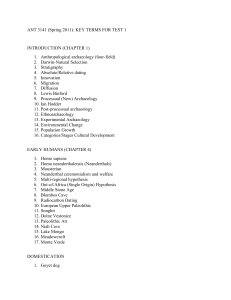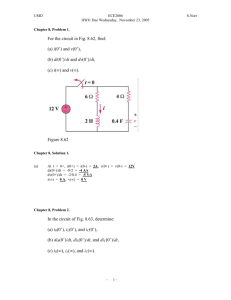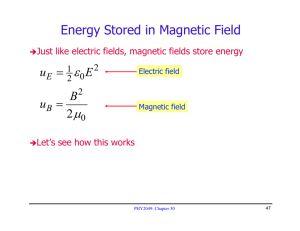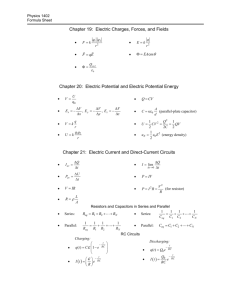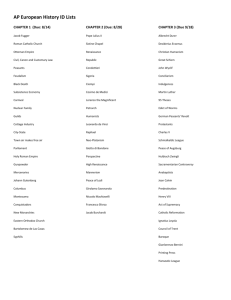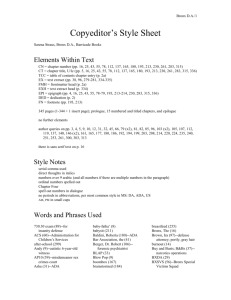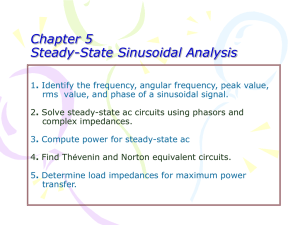Circuiti RLC: Tensione, Corrente, Impedenza, Risonanza
advertisement
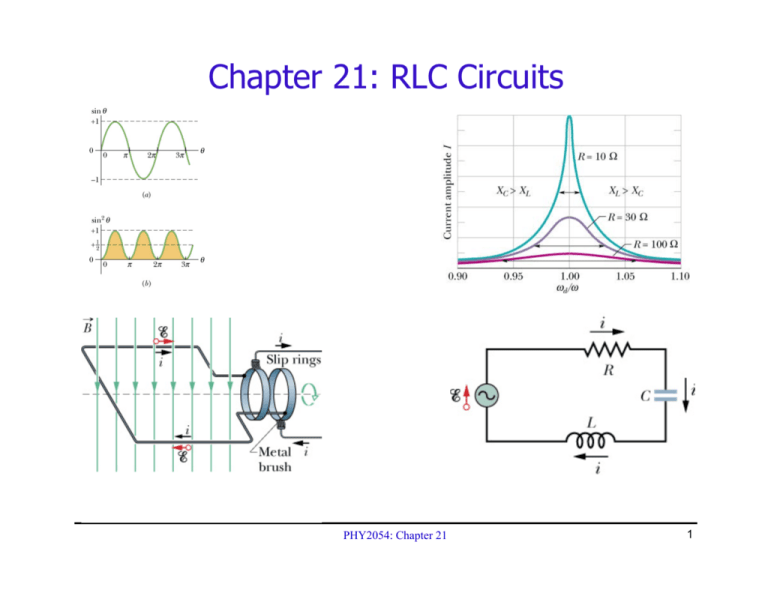
Chapter 21: RLC Circuits PHY2054: Chapter 21 1 Voltage and Current in RLC Circuits ÎAC emf source: “driving frequency” f ε = ε m sin ωt ÎIf circuit contains only R + emf source, current is simple i= ÎIf ε R = I m sin (ωt ) Im = εm R ( current amplitude ) L and/or C present, current is not in phase with emf i = I m sin (ωt − φ ) ÎZ, ω = 2π f Im = εm Z φ shown later PHY2054: Chapter 21 2 AC Source and Resistor Only ÎDriving voltage is ε = ε m sin ωt i ÎRelation of current and voltage i =ε /R i = I m sin ωt Current Im = εm ε ~ R R is in phase with voltage (φ = 0) PHY2054: Chapter 21 3 AC Source and Capacitor Only q = ε m sin ωt ÎVoltage is vC = C ÎDifferentiate to find current q = Cε m sin ωt i i = dq / dt = ωCVC cos ωt ÎRewrite using phase (check this!) i = ωCVC sin (ωt + 90° ) ÎRelation ε ~ C of current and voltage i = I m sin (ωt + 90° ) I m = ΓCapacitive Current εm XC ( X C = 1/ ωC ) reactance”: X C = 1/ ωC “leads” voltage by 90° PHY2054: Chapter 21 4 AC Source and Inductor Only ÎVoltage is vL = Ldi / dt = ε m sin ωt ÎIntegrate di/dt to find current: i di / dt = ( ε m / L ) sin ωt i = − ( ε m / ω L ) cos ωt ÎRewrite using phase (check this!) i = ( ε m / ω L ) sin (ωt − 90° ) ÎRelation ε ~ L of current and voltage i = I m sin (ωt − 90° ) I m = ΓInductive Current εm XL ( X L = ωL) reactance”: X L = ω L “lags” voltage by 90° PHY2054: Chapter 21 5 General Solution for RLC Circuit ÎWe assume steady state solution of form i = I m sin (ωt − φ ) Im is current amplitude φ is phase by which current “lags” the driving EMF Must determine Im and φ in solution: differentiate & integrate sin(ωt-φ) i = I m sin (ωt − φ ) ÎPlug di = ω I m cos (ωt − φ ) dt Im q = − cos (ωt − φ ) Substitute L di q + Ri + = ε m sin ω t dt C ω I mω L cos (ωt − φ ) + I m R sin (ωt − φ ) − Im cos (ωt − φ ) = ε m sin ωt ωC PHY2054: Chapter 21 6 General Solution for RLC Circuit (2) I mω L cos (ωt − φ ) + I m R sin (ωt − φ ) − ÎExpand Im cos (ωt − φ ) = ε m sin ωt ωC sin & cos expressions sin (ωt − φ ) = sin ωt cos φ − cos ωt sin φ cos (ωt − φ ) = cos ωt cos φ + sin ωt sin φ ÎCollect sinωt & cosωt terms separately (ω L − 1/ ωC ) cos φ − R sin φ = 0 I m (ω L − 1/ ωC ) sin φ + I m R cos φ = ε m ÎThese High school trig! cosωt terms sinωt terms equations can be solved for Im and φ (next slide) PHY2054: Chapter 21 7 General Solution for RLC Circuit (3) ÎSolve for φ and Im tan φ = ÎR, ω L − 1/ ωC R X L − XC ≡ R Im = εm Z XL, XC and Z have dimensions of resistance X L = ωL Inductive “reactance” X C = 1/ ωC Capacitive “reactance” Z = R2 + ( X L − X C ) ÎThis 2 Total “impedance” is where φ, XL, XC and Z come from! PHY2054: Chapter 21 8 Im = AC Source and RLC Circuits εm Maximum current Z X L − XC tan φ = R X L = ωL Phase angle (ω = 2π f ) X C = 1/ ωC Z = R2 + ( X L − X C ) Inductive reactance Capacitive reactance 2 Total impedance φ= angle that current “lags” applied voltage PHY2054: Chapter 21 9 What is Reactance? Think of it as a frequency-dependent resistance 1 XC = ωC Shrinks with increasing ω X L = ωL Grows with increasing ω ( "XR " = R ) Independent of ω PHY2054: Chapter 21 10 Pictorial Understanding of Reactance Z = R2 + ( X L − X C ) 2 X L − XC tan φ = R R cos φ = Z PHY2054: Chapter 21 11 Summary of Circuit Elements, Impedance, Phase Angles Z = R2 + ( X L − X C ) 2 PHY2054: Chapter 21 X L − XC tan φ = R 12 Quiz ÎThree identical EMF sources are hooked to a single circuit element, a resistor, a capacitor, or an inductor. The current amplitude is then measured as a function of frequency. Which one of the following curves corresponds to an inductive circuit? (1) a (2) b (3) c (4) Can’t tell without more info a Imax b c X L = ωL (ω = 2π f ) I max = ε max / X L f For inductor, higher frequency gives higher reactance, therefore lower current PHY2054: Chapter 21 13 RLC Example 1 ÎBelow are shown the driving emf and current vs time of an RLC circuit. We can conclude the following Current “leads” the driving emf (φ<0) Circuit is capacitive (XC > XL) I ε t PHY2054: Chapter 21 14 RLC Example 2 ÎR = 200Ω, C = 15μF, L = 230mH, εmax = 36v, f = 60 Hz X L = 2π × 60 × 0.23 = 86.7Ω X C = 1/ 2π × 60 × 15 × 10−6 = 177Ω Z = 2002 + ( 86.7 − 177 ) = 219Ω I max = ε max / Z = 36 / 219 = 0.164 A ( ) XC > XL Capacitive circuit 2 −1 ⎛ 86.7 − 177 ⎞ φ = tan ⎜ ⎝ 200 ⎟ = −24.3° ⎠ Current leads emf (as expected) i = 0.164sin (ωt + 24.3° ) PHY2054: Chapter 21 15 Resonance ÎConsider impedance vs frequency Z = R + ( X L − X C ) = R + (ω L − 1/ ωC ) 2 ÎZ 2 2 2 is minimum when ω L = 1/ ωC ω = ω0 = 1/ LC This ÎAt is resonance! resonance Impedance = Z is minimum Current amplitude = Im is maximum PHY2054: Chapter 21 16 Imax vs Frequency and Resonance ÎCircuit parameters: C = 2.5μF, L = 4mH, εmax = 10v f0 = 1 / 2π(LC)1/2 = 1590 Hz Plot Imax vs f I max = 10 / R + (ω L − 1/ ωC ) 2 2 R = 5Ω R = 10Ω Imax R = 20Ω Resonance f = f0 f / f0 PHY2054: Chapter 21 17 Power in AC Circuits ÎInstantaneous power emitted by circuit: P = i2R P = I m2 R sin 2 (ωd t − φ ) ÎMore Instantaneous power oscillates useful to calculate power averaged over a cycle Use <…> to indicate average over a cycle P = I m2 R sin 2 (ω d t − φ ) = 12 I m2 R ÎDefine RMS quantities to avoid ½ factors in AC circuits I rms = ÎHouse Vrms Im 2 ε rms = εm 2 2 Pave = I rms R current = 110V ⇒ Vpeak = 156V PHY2054: Chapter 21 18 Power in AC Circuits ÎPower formula ÎRewrite 2 Pave = I rms R I rms = I max / 2 using I rms = ε rms Pave = ε rms I rms cos φ Pave = Z ε rms R cos φ = Z Z I rms R = ε rms I rms cos φ Z φ X L − XC R Îcosφ is the “power factor” maximize power delivered to circuit ⇒ make φ close to zero Max power delivered to load happens at resonance E.g., too much inductive reactance (XL) can be cancelled by increasing XC (e.g., circuits with large motors) To PHY2054: Chapter 21 19 Power Example 1 ÎR = 200Ω, XC = 150Ω, XL = 80Ω, εrms = 120v, f = 60 Hz Z = 200 + ( 80 − 150 ) = 211.9Ω I rms = ε rms / Z = 120 / 211.9 = 0.566 A 2 2 −1 ⎛ 80 − 150 ⎞ φ = tan ⎜ ⎟ = −19.3° ⎠ Current leads emf Capacitive circuit ⎝ 200 cos φ = 0.944 Pave = ε rms I rms cos φ = 120 × 0.566 × 0.944 = 64.1W Same 2 Pave = I rms R = 0.5662 × 200 = 64.1W PHY2054: Chapter 21 20 Power Example 1 (cont) ÎR = 200Ω, XC = 150Ω, XL = 80Ω, εrms = 120v, f = 60 Hz ÎHow much capacitance must be added to maximize the power in the circuit (and thus bring it into resonance)? Want XC = XL to minimize Z, so must decrease XC X C = 150Ω = 1/ 2π fC C = 17.7μF X C new = X L = 80Ω Cnew = 33.2μF So we must add 15.5μF capacitance to maximize power PHY2054: Chapter 21 21 Power vs Frequency and Resonance ÎCircuit parameters: C = 2.5μF, L = 4mH, εmax = 10v f0 = 1 / 2π(LC)1/2 = 1590 Hz Plot Pave vs f for different R values R = 2Ω R = 5Ω Pave R = 10Ω Resonance R = 20Ω f = f0 f / f0 PHY2054: Chapter 21 22 Resonance Tuner is Based on Resonance Vary C to set resonance frequency to 103.7 (ugh!) Other radio stations. RLC response is less Circuit response Q = 500 Tune for f = 103.7 MHz PHY2054: Chapter 21 23 Quiz ÎA generator produces current at a frequency of 60 Hz with peak voltage and current amplitudes of 100V and 10A, respectively. What is the average power produced if they are in phase? (1) (2) (3) (4) (5) 1000 W 707 W 1414 W 500 W 250 W Pave = 12 ε peak I peak = ε rms I rms PHY2054: Chapter 21 24 Quiz ÎThe figure shows the current and emf of a series RLC circuit. To increase the rate at which power is delivered to the resistive load, which option should be taken? (1) Increase R (2) Decrease L (3) Increase L (4) Increase C X L − XC tan φ = R Current lags applied emf (φ > 0), thus circuit is inductive. Either (1) Reduce XL by decreasing L or (2) Cancel XL by increasing XC (decrease C). PHY2054: Chapter 21 25 Example: LR Circuit frequency EMF source with εm=6V connected to a resistor and inductor. R=80Ω and L=40mH. ÎVariable At what frequency f does VR = VL? X L = ω L = R ⇒ ω = 2000 At f = 2000 / 2π = 318Hz that frequency, what is phase angle φ? tan φ = X L / R = 1 ⇒ φ = 45° What is the current amplitude and RMS value? I max = ε max / 802 + 802 = 6 /113 = 0.053A I rms = I max / 2 = 0.037 A i = 0.053sin (ωt − 45° ) PHY2054: Chapter 21 26 Transformers ÎPurpose: change alternating (AC) voltage to a bigger (or smaller) value Input AC voltage in the “primary” turns produces a flux Vp = N p Changing flux in “secondary” turns induces an emf ΔΦ B Vs = N s Δt ΔΦ B Δt Ns Vs = V p Np PHY2054: Chapter 21 27 Transformers ÎNothing comes for free, however! Increase in voltage comes at the cost of current. Output power cannot exceed input power! power in = power out (Losses usually account for 10-20%) i pVp = isVs is V p N p = = i p Vs N s PHY2054: Chapter 21 28 Transformers: Sample Problem ÎA transformer has 330 primary turns and 1240 secondary turns. The input voltage is 120 V and the output current is 15.0 A. What is the output voltage and input current? Ns ⎛ 1240 ⎞ Vs = V p = 120 ⎜ ⎟ = 451V Np ⎝ 330 ⎠ i pV p = isVs “Step-up” transformer Vs ⎛ 451 ⎞ i p = is = 15 ⎜ ⎟ = 56.4 A Vp ⎝ 120 ⎠ PHY2054: Chapter 21 29 Transformers ¾ This is how first experiment by Faraday was done ¾ He only got a deflection of the galvanometer when the switch is opened or closed ¾ Steady current does not make induced emf. PHY2054: Chapter 21 30 Applications Microphone Tape recorder PHY2054: Chapter 21 31 ConcepTest: Power lines ÎAt large distances, the resistance of power lines becomes significant. To transmit maximum power, is it better to transmit (high V, low i) or (high i, low V)? (1) high V, low i (2) low V, high i (3) makes no difference Power loss is i2R PHY2054: Chapter 21 32 Electric Power Transmission i2R: 20x smaller current ⇒ 400x smaller power loss PHY2054: Chapter 21 33
